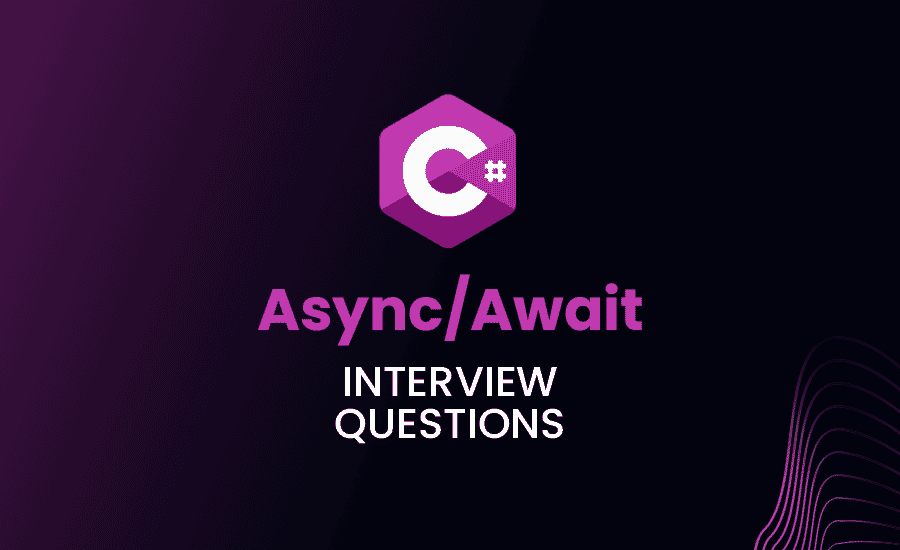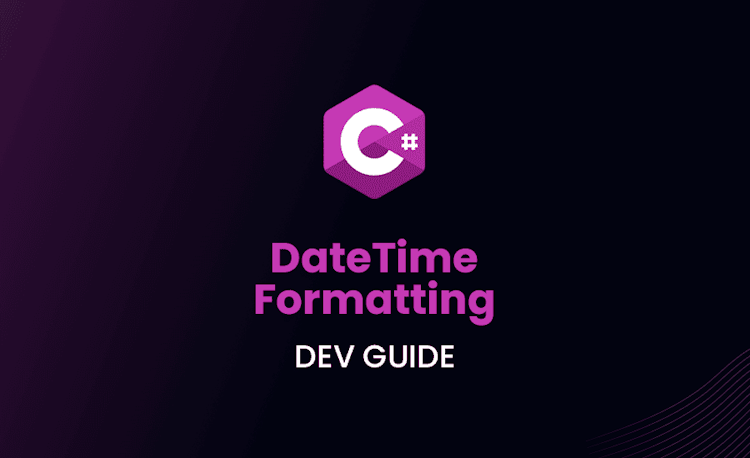C# Async/Await Interview Questions And Answers

Are you preparing for an interview that will involve C# asynchronous programming? You’ve come to the right place! This comprehensive article covers a wide range of C# async-await interview questions that will test your understanding of the async-await pattern, along with solutions and examples to help you sharpen your skills.
From fundamental concepts to advanced techniques, this article covers async and await in C# interview questions that you’re likely to encounter during your technical interview.
In C# async-await, what is the main difference between
Answer
ConfigureAwait is a method used with await to control how the execution of the async method should continue after the completion of the awaited task. It takes a boolean value as its argument, allowing developers to specify whether or not to continue on the captured synchronization context or a different context.
ConfigureAwait(false)is used when you do not want to resume execution on the captured synchronization context upon completion of the awaited task. In many cases, this is used to prevent deadlocks and improve performance, especially for library or non-UI code.
Loading code snippet...
ConfigureAwait(true)is used to maintain the synchronization context (if any) and resume execution of the awaited task on that context. This is the default behavior whenConfigureAwaitis not explicitly called. It’s useful in cases where you want to maintain the captured context, such as updating UI components or changing global state shared by multiple threads. You rarely need to useConfigureAwait(true)explicitly because it’s the default behavior but here’s an example:
Loading code snippet...
Note: In UI-based applications, the captured context will be the UI context (e.g. the main UI thread in WPF or WinForms applications). In this case, it’s essential to maintain the synchronization context when performing UI updates, so you’d use ConfigureAwait(true) or not use ConfigureAwait at all.
How does the
Answer
Task.WhenAll is a method provided by the Task class that takes an IEnumerable<Task> or a set of Task instances as parameters and returns a new Task that completes once all input tasks have completed.
Uses:
- It’s useful when you need to perform multiple asynchronous operations concurrently and wait for all of them to complete.
- It works by internally creating a new task that handles each child task’s completion and signals when all child tasks have finished.
Potential issues:
- : When using
Task.WhenAll, exceptions thrown by individual tasks are wrapped in anAggregateException. It’s crucial to handle thisAggregateExceptionand to unwrap it to understand the actual exceptions that occurred in the tasks. Otherwise, you may miss critical exceptions or experience unexpected behavior.
Loading code snippet...
- Thread Starvation: If you’re not careful about how many tasks you’re waiting for concurrently, your application may experience thread starvation, especially in cases where your tasks have a high degree of parallelism. Consider using
SemaphoreSlimor other concurrency control methods to limit the number of concurrent tasks. - Resource Exhaustion: Running an excessive number of tasks concurrently can lead to memory pressure, file handle exhaustion, or network limitations. Pay attention to system resources when using
Task.WhenAlland consider limiting concurrency to available resources to avoid potential issues.
In C# async-await, how can deadlocks occur, and what are some effective techniques to avoid them in your application?
Answer
Deadlocks can occur in async-await when you synchronously block on an async method, causing the caller and the callee to wait for each other, effectively causing a deadlock.
Imagine the following scenario in a UI-based application:
Loading code snippet...
The ButtonClickHandler method is waiting for DoSomethingAsync to complete. At the same time, DoSomethingAsync is waiting for the SomeOperationAsync() to complete. Because the await statement by default captures the synchronization context (UI context in this case), the continuation of SomeOperationAsync requires UI context. However, the UI context is blocked by the call to DoSomethingAsync().Wait(), and consequently, the deadlock happens.
To avoid deadlocks, follow these guidelines:
- Do not use blocking calls like
.Wait()or.Resulton async methods. Instead, use async andawaitall the way up:
Loading code snippet...
- Use
ConfigureAwait(false)whenever possible in your async methods, especially in library code or when you don’t need to rely on the captured synchronization context. This can prevent deadlocks when blocking calls are made to async methods. - Avoid using a mixture of sync and async code, and always follow the async-all-the-way pattern. This pattern helps prevent deadlocks, improves code readability and maintainability.
What is the purpose of the
Answer
The IAsyncDisposable interface is used to provide an asynchronous mechanism to release unmanaged resources, whereas the IDisposable interface is used for synchronous resource cleanup. When working with asynchronous operations, IAsyncDisposable allows you to perform non-blocking cleanup tasks.
Implementing IAsyncDisposable requires that you provide an async ValueTask DisposeAsync() method. Typically, IAsyncDisposable is used with classes or objects that have async methods and also hold onto unmanaged resources such as file handles, network connections, or database connections.
To use a class implementing IAsyncDisposable, you can use the await using statement, which ensures that resources are released in an asynchronous and non-blocking manner:
Loading code snippet...
Remember that while implementing IAsyncDisposable, you should also implement the IDisposable interface to allow users to dispose of resources synchronously if needed.
Explain how the
Answer
The ValueTask structure represents an operation that will produce a result in the future, similar to the Task class. However, the main difference is that ValueTask is a value type (struct), whereas Task is a reference type (class). This means that ValueTask instances are usually created on the stack, and they have lower memory overhead compared to Task.
ValueTask is mainly designed for use in high-performance scenarios or when a method is expected to return synchronously most of the time. Using ValueTask instead of Task can help reduce memory allocations and improve performance when asynchronous overhead is not needed for the majority of calls.
Example scenario:
Loading code snippet...
In this example, we use ValueTask<int> because we expect that most of the time, the value will be returned synchronously from the cache. When the value is not available in the cache, we only then perform the asynchronous operation (ComputeResultAsync). Using ValueTask<int> will reduce the memory allocations for the method call when the value is returned from the cache.
It is important to note that ValueTask should not always be the default choice over Task. You should only consider using ValueTask in performance-critical scenarios, and after carefully analyzing the trade-offs and potential implications on the API’s usage. Avoiding the use of async and await with ValueTask when not necessary can lead to non-obvious logic bugs and unexpected behavior.
Now that we’ve covered the basics of async-await and the differences between ValueTask and Task, it’s time to dive into more advanced techniques, like the concept of async parallelism.
Employing parallel strategies can further improve the efficiency and performance of your async code. Keep reading to explore the benefits and potential drawbacks of this approach.
How can you implement the concept of “async parallelism” in C#, and what are the potential advantages or drawbacks of using this approach?
Answer
Async parallelism refers to the execution of multiple asynchronous operations concurrently, usually with the goal of improving performance by completing tasks in less overall time. In C#, you can achieve async parallelism using various techniques, including Task.WhenAll or the SemaphoreSlim class in combination with multiple async Task instances.
Here’s an example of using Task.WhenAll to achieve async parallelism:
Loading code snippet...
Advantages:
- Performance improvement: By performing multiple asynchronous operations concurrently, your application can complete tasks in a shorter amount of time, improving overall performance.
- Better resource utilization: Async parallelism allows you to utilize system resources more effectively, such as CPU, I/O, and network bandwidth.
Drawbacks:
- Complexity: Implementing async parallelism can be more complex than sequential execution, making it harder to reason about, debug, and maintain.
- Increased resource usage: Depending on the workload and the number of concurrent tasks, async parallelism may lead to increased resource usage, which can cause resource exhaustion, thread starvation, or other performance problems if not managed carefully.
- Exception handling: Handling exceptions can be more challenging with async parallelism, as multiple tasks can throw exceptions at the same time.
How does the
Answer
The TaskCompletionSource<TResult> class allows you to wrap non-async code that utilizes callbacks or other non-awaitable patterns into a Task<TResult> that can be awaited.
TaskCompletionSource provides a Task property that represents the ongoing operation and a set of methods to set the result, exception, or cancellation of the operation, typically used within callbacks or event handlers.
Here’s an example of using TaskCompletionSource to wrap a non-async timer:
Loading code snippet...
Potential pitfalls:
- Synchronization context: Make sure to avoid capturing the synchronization context in the callbacks when using
TaskCompletionSource(useConfigureAwait(false)when possible). Otherwise, you may introduce deadlocks or other issues related to synchronization context dependencies. - Exception handling: When using
TaskCompletionSource, ensure that you handle exceptions appropriately, either by passing them to theSetExceptionmethod or handling them within your callback methods. - Resource leaks: Be careful to clean up any resources used by your non-async code (e.g., event handlers, timers, network connections) when using
TaskCompletionSourceto convert it to async-await code, to prevent leaks or unwanted side effects.
When is it appropriate to apply the
Answer
SemaphoreSlim is a lightweight, async-compatible semaphore that can be used to limit concurrent access to a shared resource or control the degree of parallelism executed in async-await scenarios.
The SemaphoreSlim class is appropriate when you have a limited number of resources or need to control the number of concurrent async operations to prevent exhaustion, high memory usage, or other performance issues.
Here’s an example of using SemaphoreSlim to limit the number of concurrent database reads:
Loading code snippet...
When controlling concurrency with SemaphoreSlim, remember to:
- Properly release resources by correctly using
WaitAsync()andRelease()methods. - Be aware of potential deadlocks or synchronization issues when setting the maximum concurrency level.
- Combine
SemaphoreSlimwith other mechanisms like throttling, batching, or retry policies to ensure a more robust concurrency solution.
How does exception handling work for asynchronous methods in C#, and what are some common practices to ensure proper error handling in async-await scenarios?
Answer
Exception handling in async-await scenarios is similar to that in synchronous scenarios, with the primary difference being the use of async Task instead of synchronous methods. Exceptions in asynchronous methods are caught and rethrown in the same way as synchronous methods, using try-catch blocks. The main difference is that exceptions occurring in async methods are propagated when the resulting task is awaited.
Here are some common practices for handling exceptions in async-await scenarios:
- Use blocks in async methods: Protect critical sections of your async code with try-catch blocks, just as you would with synchronous code.
Loading code snippet...
- Catch exceptions on : When awaiting a task, you can catch exceptions right on the
awaitstatement.
Loading code snippet...
- Handle multiple exceptions: When using
Task.WhenAllto handle multiple tasks concurrently, use a try-catch block to handleAggregateExceptions thrown by any of the tasks. Unwrap theAggregateExceptionto handle each individual exception as necessary.
Loading code snippet...
- Use with try-catch: When using try-catch blocks inside library code or non-UI scenarios, use
ConfigureAwait(false)when awaiting tasks to prevent capturing the synchronization context and causing potential deadlocks.
Loading code snippet...
- Utilize exception filters: C# 6 introduced exception filters using the
whenkeyword in catch clauses. This can be helpful to add conditional logic to your exception handling based on the state of the exception or other factors.
Loading code snippet...
In C# async-await, what is the purpose of the
Answer
The Task.Yield method returns an awaitable YieldAwaitable structure, which, when awaited, causes the async method to suspend its execution and immediately yield control back to the calling method. This allows other tasks or work items to execute while the async method awaits the YieldAwaitable.
Task.Yield is particularly useful in situations where you need to ensure that a long-running or iterative async operation does not monopolize the current thread or synchronization context, which would block other operations or degrade the performance of your application.
Common use cases for Task.Yield include:
- UI responsiveness: In UI scenarios, long-running computations or iterations can cause the UI to freeze. By inserting an
await Task.Yield();statement in your code, you allow the UI to remain responsive by periodically yielding control back to the UI thread.
Loading code snippet...
- Fair scheduling: In situations where multiple operations are awaiting a shared resource or competing for system resources, using
Task.Yieldcan help to ensure a more fair scheduling of the work items and prevent resource monopolization.
Loading code snippet...
Keep in mind that the use of Task.Yield can introduce additional overhead and may not always be necessary. It’s essential to carefully analyze the specific use case and circumstances to determine if Task.Yield would improve your application’s performance and responsiveness or cause unnecessary delays.
Having explored various async-await patterns and techniques in C#, it’s essential to understand how to apply async-await to other aspects of the language, such as LINQ queries.
Asynchronous programming can significantly impact the execution of queries, so let’s discuss the precautions you need to take when using async-await with LINQ.
How does async-await impact the execution of LINQ queries in C#, and what precautions should be taken to prevent potential issues related to deferred execution?
Answer
When using LINQ with async-await, it’s important to note that most standard LINQ operators (such as Where, Select, GroupBy, etc.) do not have built-in support for asynchronous operations. LINQ queries with standard operators are executed synchronously, which can cause blocking issues when executed in async methods, especially when processing large datasets.
To handle asynchronous processing with LINQ, consider the following precautions and best practices:
- Load data asynchronously: Before executing your LINQ queries, use async-await to asynchronously load or fetch the data you’ll operate on. This will help prevent blocking on I/O-bound operations.
Loading code snippet...
- Use asynchronous LINQ libraries: Consider using libraries like System.Interactive.Async (also known as Interactive Extensions or Ix.Async) or Entity Framework Core, which provide asynchronous versions of LINQ operators. These libraries allow you to chain async LINQ operations and perform end-to-end asynchronous processing for your queries.
Loading code snippet...
- Be mindful of deferred execution: When working with LINQ and async-await, be aware of the principle of deferred execution. LINQ queries don’t execute until the results are enumerated, which often happens asynchronously. To avoid potential issues, materialize the query results explicitly and asynchronously using methods like
ToListAsync()orToArrayAsync()in the async LINQ libraries before performing additional async operations on the results.
Loading code snippet...
How can you achieve bi-directional async communication between a server and client in C# using async-await, and what are some important considerations for implementing this communication pattern?
Answer
Bi-directional async communication refers to a communication pattern where both the server and the client can send and receive messages asynchronously. To achieve this in C#, you can use various techniques, including WebSocket, SignalR, gRPC, or custom protocols built on top of TCP or UDP.
Here’s an example of using WebSocket and async-await for bi-directional communication:
Server-side:
Loading code snippet...
Client-side:
Loading code snippet...
Important considerations:
- Concurrency: As both client and server can send messages at any time, be prepared to handle concurrent message processing or decide on a messaging protocol to handle the concurrency.
- Message framing: Depending on the protocol you choose for communication, you may need to handle message framing, which includes message boundaries, content encoding, and other metadata.
- Error handling: Implement error handling for various scenarios such as connection drops, message processing errors, and protocol violations.
- Security: When implementing bi-directional async communication, consider adding security measures like authentication, authorization, encryption, and message integrity validation.
What is the concept of “async streams” in C#, and how can you utilize the
Answer
Async streams are a C# feature introduced in C# 8.0, which allows you to asynchronously iterate over data streams. Instead of loading the entire data set into memory, async streams enable processing items one at a time asynchronously by combining the power of async-await with the traditional IEnumerable pattern.
The IAsyncEnumerable<T> interface is the core element of async streams, and it represents an asynchronous collection that can be enumerated one item at a time. To consume and produce async streams, the await foreach statement and async iterator methods using yield return are used, respectively.
For example, let’s create a method that produces an IAsyncEnumerable of items:
Loading code snippet...
To consume the items produced by this method, you can use the await foreach statement to asynchronously iterate over the items:
Loading code snippet...
Using IAsyncEnumerable<T> and async streams offers the following benefits:
- Efficient data processing: Async streams enable processing large or potentially unbounded data streams with reduced memory usage, as items are loaded and processed one at a time asynchronously.
- Simplified asynchronous iteration: Using async-await with the familiar iterator pattern brings more readable and maintainable asynchronous iteration code compared to manual implementations using tasks and callbacks.
How does the
Answer
The Task.Run method is a static method provided by the Task class. It’s used to offload work to be executed on the ThreadPool, which can help achieve better responsiveness or parallelism by leveraging background threads.
The primary use case for Task.Run is to offload CPU-bound operations from the main thread or a UI thread. With async-await, Task.Run enables you to run these CPU-bound operations in the background and asynchronously await their completion.
Here’s an example of using Task.Run:
Loading code snippet...
When using Task.Run, keep in mind the following factors:
- Only offload CPU-bound or blocking operations: Use
Task.Runfor CPU-bound operations or when an API runs synchronously and consumes a significant amount of time. Avoid usingTask.Runfor I/O-bound operations, as the async-await pattern is more suitable for handling I/O with non-blocking concurrency. - Consider UI responsiveness: When working with UI applications, be cautious about offloading work to the ThreadPool, as excessive use of
Task.Runcan cause ThreadPool starvation and impact UI responsiveness. In such cases, consider using other mechanisms like task scheduler, dedicated worker threads, or parallel processing techniques. - Properly handle exceptions: When using
Task.Run, exceptions thrown within the delegate are propagated when youawaitthe task. Be sure to handle exceptions appropriately and avoid unobserved exceptions. - Avoid nested calls: Don’t use
Task.Runwithin anotherTask.Rundelegate. This can lead to ThreadPool starvation and reduced performance. Consider using more advanced patterns likeTask.WhenAll,SemaphoreSlim, or parallelism features likeParallel.ForEachto create more structured parallelism.
In C# async-await, how can you prevent the primary thread from blocking while waiting for the result of an asynchronous operation, without resorting to busy waiting or spinning?
Answer
The key to preventing the primary thread (e.g., UI thread) from blocking is to fully embrace the async-await pattern when working with asynchronous operations. Avoid using synchronous blocking mechanisms like .Wait() or .Result when waiting for async operations, as they can cause deadlocks and block the primary thread.
To ensure non-blocking behavior and prevent the primary thread from waiting, follow these practices:
- Use async methods and await their results: Always prefer async methods and use the
awaitkeyword when calling them. This will allow the calling method to return control back to the caller, letting the primary thread continue processing other tasks and remaining responsive.
Loading code snippet...
- Async all the way up: Apply the async-await pattern consistently throughout your call stack. This typically means changing your event handlers, delegates, or callbacks to use async methods and the
awaitkeyword.
Loading code snippet...
- Offload CPU-bound work using : If you need to perform long-running CPU-bound operations, use
Task.Runto offload the work to the ThreadPool to prevent blocking the primary thread.
Loading code snippet...
Following these practices will ensure that the primary thread doesn’t get blocked while waiting for asynchronous operations to complete, maintaining responsiveness and high performance in your application.
At this point, you have a solid grasp of the essential async-await patterns and practices in C#. The next step is to deep-dive into advanced topics such as task scheduling and customizing execution using the TaskScheduler class.
These advanced techniques can further enhance your async programming skills and help you tackle complex asynchronous scenarios in C#.
What is the role of the
Answer
The TaskScheduler class is a core component of the Task Parallel Library (TPL) in C#. It is responsible for controlling how tasks are scheduled and executed by the underlying ThreadPool. By default, tasks executed by Task.Run, Task.Factory.StartNew, and other async methods use the default TaskScheduler, which schedules tasks on the ThreadPool.
When implementing advanced async scenarios, you may need to consider customizing the TaskScheduler to meet specific requirements or improve performance. Custom task schedulers allow you to control how and when tasks are executed, potentially enabling better resource management, prioritization, or integration with other frameworks, application domains, or synchronization contexts.
For example, you may create a custom TaskScheduler that schedules tasks on a specific thread or using a specific synchronization context, like the UI thread in a Windows Forms application:
Loading code snippet...
When customizing the TaskScheduler, consider these factors:
- Compatibility: Ensure that your custom scheduler is compatible with the specific async-await scenarios and APIs used in your application.
- Performance: Test and optimize the performance of your custom scheduler, as it may have a significant impact on the overall performance of your async operations.
- Error handling: Implement proper exception handling in your custom scheduler, making sure to propagate exceptions and handle them gracefully where necessary.
- Integration: If your custom scheduler needs to work with specific synchronization contexts or other frameworks, it’s essential to implement seamless integration and avoid potential deadlocks, performance issues, or synchronization problems.
How can you implement custom cancellation logic for async processes in C# using the
Answer
The CancellationTokenSource and CancellationToken classes enable you to implement custom cancellation logic for async operations in C#. A CancellationTokenSource can be used to generate CancellationTokens, which can then be passed to your async methods, allowing them to respond to cancellation requests.
Here’s an example of implementing custom cancellation logic using a CancellationTokenSource:
Step 1: Create a CancellationTokenSource and obtain a CancellationToken:
Loading code snippet...
Step 2: Pass the CancellationToken to the async method:
Loading code snippet...
Step 3: Call the async method, pass the CancellationToken, and handle the cancellation exception:
Loading code snippet...
Step 4: Trigger cancellation by calling the Cancel() method on the CancellationTokenSource:
Loading code snippet...
When implementing custom cancellation logic, consider these factors:
- Pass CancellationToken: Always pass
CancellationTokenparameters down the call chain to enable cancellation in all async methods involved. - Check cancellation frequently: Use
cancellationToken.ThrowIfCancellationRequested()frequently in your async method to check if a cancellation has been requested and respond promptly. - Handle OperationCanceledException: Be sure to handle the
OperationCanceledExceptionthat may be thrown when cancellation is requested. - Dispose CancellationTokenSource: Properly dispose of the
CancellationTokenSourcewhen it’s no longer needed to prevent resource leaks.
In C# async-await, what are some common performance concerns and optimization techniques to ensure that async code is running efficiently in a production environment?
Answer
When designing and optimizing async code for performance, it’s critical to address several common performance concerns and apply specific techniques:
- Minimize allocations and overhead: Avoid creating unnecessary tasks, especially when using async methods in loops or constructing lots of short-lived tasks. This may cause a significant overhead, increased memory usage, and increased GC pressure. Consider using the
ValueTaskstructure or caching tasks if possible. - Optimize synchronization contexts: By default, async methods capture the synchronization context when they start, and this can lead to performance issues in certain scenarios. Always use
ConfigureAwait(false)when you don’t need the synchronization context for further operations (e.g., when writing library code or non-UI code). - Optimal use of Task.Run: Be careful when using
Task.Runto offload work, as excessive use can cause ThreadPool congestion and degrade overall performance. UseTask.Runprimarily for CPU-bound work, and use the appropriate degree of parallelism to avoid resource contention. - Ensure proper exception handling: Unhandled exceptions in async code can lead to unexpected application failures or unobserved task exceptions. Make sure to catch and handle exceptions properly in your async methods and use appropriate error handling patterns, such as using
Task.WhenAllwithAggregateExceptionhandling. - Control concurrency: When running multiple async operations concurrently, carefully control the degree of concurrency using mechanisms like
SemaphoreSlim, batching, or throttling to avoid resource exhaustion, thread starvation, or performance degradation. - Avoid deadlocks: Deadlocks can be a significant performance concern in async code, especially when mixing async-await with synchronous code or incorrect usage of blocking mechanisms. Always use async-await consistently and avoid using
.Wait()or.Resulton async methods to prevent deadlocks. - Measure and profile performance: Use performance profiling and diagnostics tools like Visual Studio Diagnostics or PerfView to monitor and optimize the performance of your async code. Ensure that your code meets your performance expectations, and be proactive in resolving potential bottlenecks or issues.
How does async-local state work in C#, and what should developers be aware of when using this feature with async-await to maintain state across asynchronous invocations?
Answer
Async-local state is a way to maintain state across async method invocations within the same logical execution context, similar to how ThreadLocal<T> maintains state across thread executions. The AsyncLocal<T> class is used to manage async-local state in C#, allowing you to store data that is specific to a given asynchronous control flow.
Here’s an example of using AsyncLocal<T> to store values across async method invocations:
Loading code snippet...
When using async-local state with async-await, developers should be aware of the following considerations:
- Understand the execution context: Async-local state is tied to the logical execution context rather than the thread itself. When async code crosses the boundaries of its context due to scheduling or thread switching, the state is preserved and can still be accessed.
- Scoping: Be cautious when scoping async-local state, as it can be accessed by any async method in the same logical control flow, potentially leading to unintentional side effects or data leaks.
- Performance: Keep in mind that accessing async-local state adds some overhead to the execution of async operations. Ensure that your usage of async-local state is optimized for performance, and avoid using it when it’s not necessary.
- Error handling: Be aware that exceptions thrown in async methods can impact the async-local state if the state is not properly synchronized or reset. Make sure to handle exceptions and clean up or restore the state as needed.
What are some strategies for efficiently combining multiple async operations into a single composition unit in a C# application using async-await?
Answer
When building complex applications, it’s often necessary to combine multiple async operations to provide a unified, cohesive unit of work. Several strategies are available to help you efficiently combine async operations in your C# application:
- Task.WhenAll: Use
Task.WhenAllto concurrently execute multiple async operations and await their results in an aggregated manner. This strategy is suitable when you need to execute multiple independent tasks concurrently and use their results together.
Loading code snippet...
- Task.WhenAny: Use
Task.WhenAnyto efficiently process tasks as they complete when you have multiple operations running concurrently, and you want to process results as they arrive or wait for the first operation to complete.
Loading code snippet...
- Task.ContinueWith: Use
Task.ContinueWithto attach a continuation to a task that executes when the task is completed. This allows you to chain operations while still having a single, combined composition unit. However, prefer using async-await whenever possible, as it provides a more readable and maintainable code structure.
Loading code snippet...
- Nested async methods: When combining multiple async operations, you can also create nested async methods that perform partial compositions, making it easier to manage the complexity and maintainability of your application logic.
Loading code snippet...
By using these strategies, you can efficiently combine multiple async operations into a single composition unit, improving code organization, readability, and maintainability in your C# application.
In summary, mastering async-await concepts in C# is crucial for building efficient and maintainable applications. This article covered essential aspects such as TaskScheduler, custom cancellation logic, performance, async-local state, and combining async operations. Continuously exploring these topics will greatly contribute to your professional growth and success in C# development.





